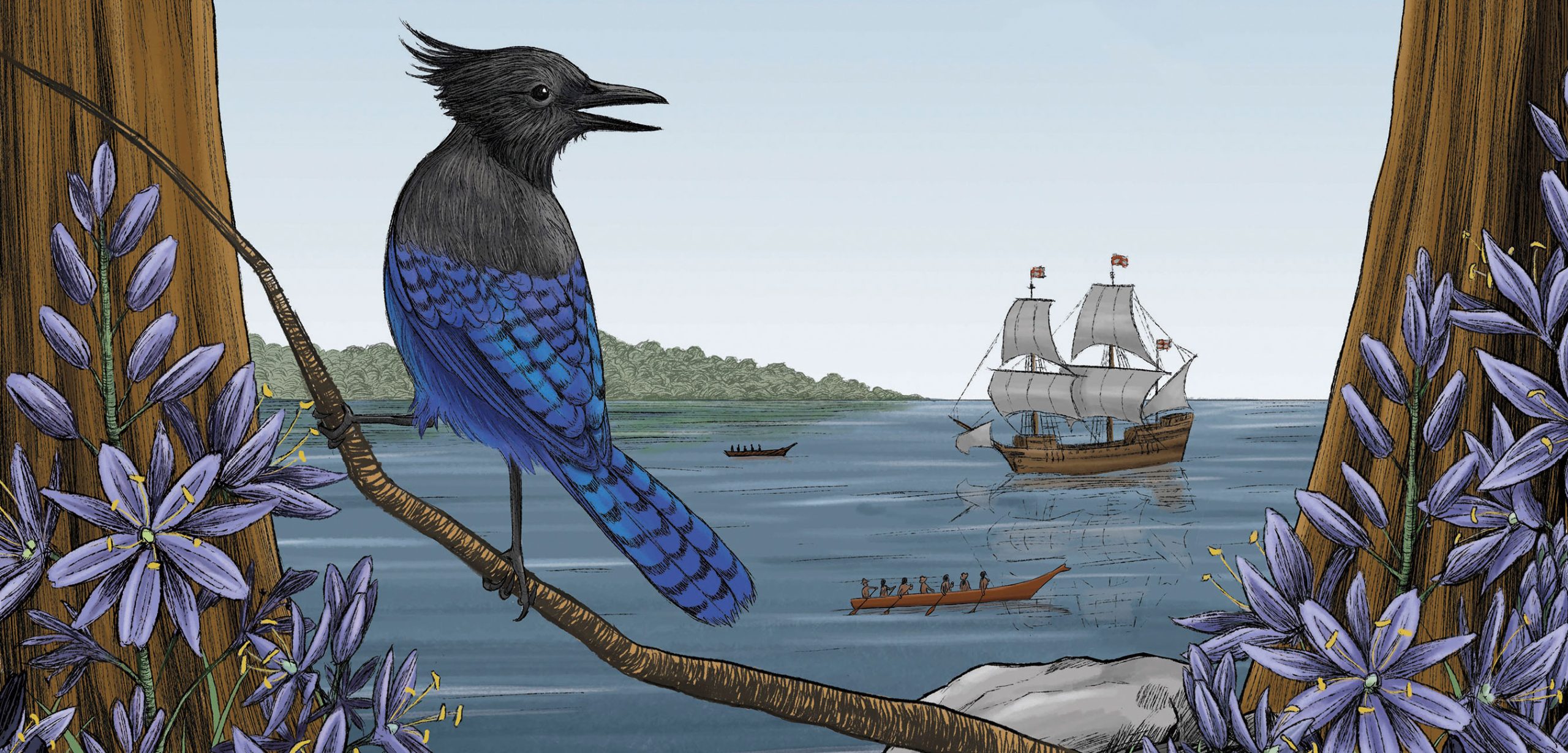Ten Coastal Kids’ Books Offer an Ocean of Adventure
From the poles to puddles, this season’s selection of books wanders our fascinating world.
Article body copy
When the woes of the world become too much, people often turn to books. They help us understand but also provide solace, distraction, or even humor in tough times. Books for children are no different. Their themes can seem simple, but they have layers of nuance and sophistication and offer multiple entry points for talking about tough topics. This fall’s coastal-themed crop of books for young readers is full of adventure—expeditions to the Arctic and a search for the world’s biggest eye, for instance—as well as journeys much closer to home, journeys of understanding and empathy, and those that navigate confusion and grief. Whether the young person in your life is looking for a seafaring tale, a scientific quest, or a splish-sploshing, puddle-jumping romp around the block, an adventure awaits in this selection of new books.
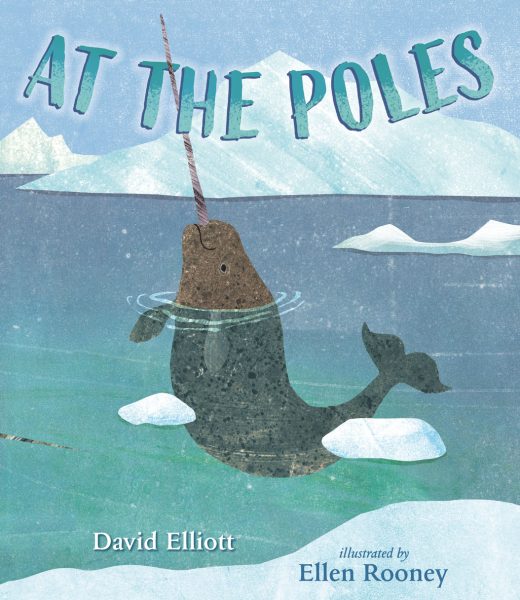 At the Poles
At the Poles
Text by David Elliott
Illustrations by Ellen Rooney
32 pp. Candlewick Press
Author David Elliott uses poetry to celebrate 15 creatures in At the Poles, the eighth book in his series that explores habitats through poetry. The large-format book gives each animal ample room to shine visually, and the vibrant art infuses color into otherwise stark polar landscapes. By clearly dividing the animals into the north and south polar regions, Elliott dispenses with any confusion over which animals live where—there’s no mingling of polar bears and penguins in these pages—and includes both the familiar, such as the narwhal (“A singular creature / with a singular feature”), and the more obscure, like the chubby microscopic tardigrade, or “moss piglet,” rendered in a paper collage style that would make a great jumping-off point for an art class.
Poems vary in stanza length, and Elliott doesn’t shy away from words such as ambulation, amplitude, pinniped, or superlative to stretch a young reader’s vocabulary. The text occasionally plays visually on the page, too, such as when diving shags (cormorants) scatter a school of small fish along with the poem’s words.
Two pages of endnotes provide more natural history details and clues that help explain some of Elliott’s word choices, such as those used in his poem about killer whales, Orcinus orca. Noting the etymology of Orcus, a Roman god of the underworld, for example, elucidates the stanza, “You are a master of predation / from / the kingdom of the dead.” From wordplay to natural science and art, At the Poles provides various points of engagement for young readers and artists.
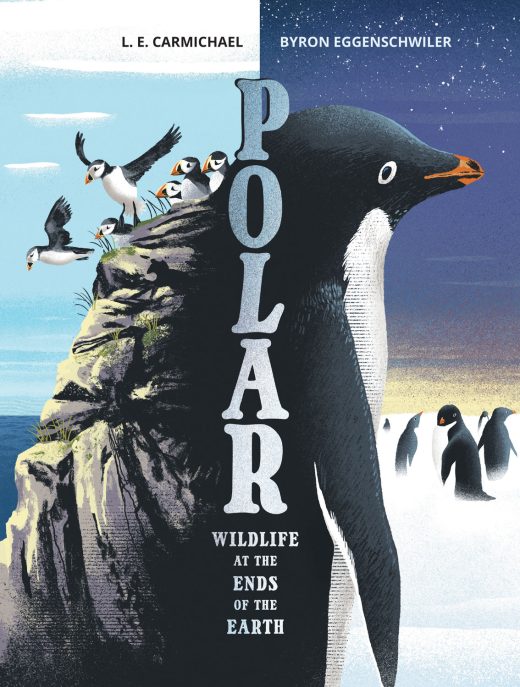 Polar: Wildlife at the Ends of the Earth
Polar: Wildlife at the Ends of the Earth
Text by L. E. Carmichael
Illustrations by Byron Eggenschwiler
48 pp. Kids Can Press
L. E. Carmichael’s Polar also tackles life at the poles but in nonfiction. However, this is no stiff “information book,” as nonfiction is often classified. Carmichael is a stellar writer who blends in lyrical prose throughout—“fingers of light stroke the soil at a boulder’s base,” a caterpillar “breaks free of her winter wrapper,” and “moonbeams waltz across snowdrifts.” This writerly skill makes Polar a fabulous resource for language arts and science.
Each spread focuses on a different polar challenge—for instance, staying warm, finding food, or how to set one’s internal clock (circadian rhythm) to help “make the most of the midnight sun … or survive the polar night”—and then gives a specific example from the Arctic and the Antarctic. The entries also follow the calendar year. In the spread on migration, we learn how, in April, Arctic belugas are moving north as the ice begins to break up, while in Antarctica, sperm whales are swimming from the warm tropical seas to the cold, squid-rich Southern Ocean. This compare and contrast at the species level is bolstered by sections on the similarities and differences of the poles themselves, such as how the “Arctic is an ocean surrounded by land,” while “Antarctica is land surrounded by an ocean.”
Byron Eggenschwiler’s engaging illustrations support the text well. Young artists will enjoy seeing how he sometimes ties together two disparate images across the book’s gutter, such as in the spread where the back of a penguin on the right (Antarctic) page becomes a nesting cliff of puffins on the left (Arctic) page.
The book wraps up with the challenging bits—climate change, plastic pollution, and such—but the entries are short and clear, with options for how young readers can take action.
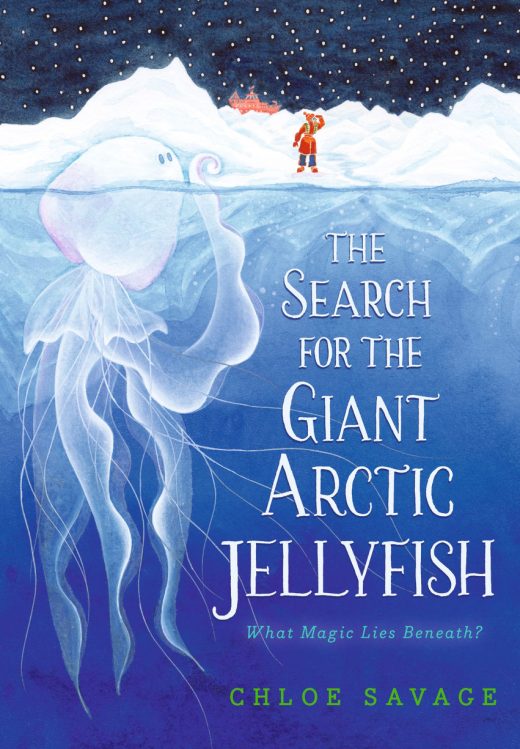 The Search for the Giant Arctic Jellyfish
The Search for the Giant Arctic Jellyfish
Text and illustrations by Chloe Savage
32 pp. Candlewick Press
Dr. Morley is off to the Arctic in pursuit of a creature that everyone talks about, but no one has seen. The eponymous star of the book—the elusive “giant Arctic jellyfish”—is fanciful, not factual, but it’s okay to let that go and imagine what it might be like to be a researcher embarking on an Arctic expedition. The Search for the Giant Arctic Jellyfish, for children ages three to seven, offers lots to delight young readers, especially those who love detail. Author-illustrator Chloe Savage uses a variety of styles and perspectives, from a two-page scene of Morley diving in a sea of jellyfish to small vignettes of her at various stages in her journey (plotting the ship’s route, sitting at a microscope, or dressing in multiple layers for outdoor exploration) to full-spread cutaway views showing the scientists and crew at work, or rest, throughout the ship.
Although scientists who have actually been on an expedition might balk at some of the book’s more whimsical details—four-poster beds and houseplants in sleeping quarters, for example—Savage gets across the point that “doing science” often means long hours, tedious tasks, and challenging conditions. It can also mean that researchers might not see what they’re searching so hard for. But young readers will delight in the fact that they can. Savage beautifully employs the technique of dramatic irony—showing readers the jellyfish in clear view on one side of an iceberg, for instance, while the crew is on the other side, captivated by a pod of belugas. The jellyfish, it turns out, has been with them all along.
 The Raven Boy
The Raven Boy
Text by Rosemarie Avrana Meyok
Illustrations by Marcus Cutler
28 pp. Inhabit Media
In The Raven Boy, author Rosemarie Avrana Meyok retells a traditional story from “long ago, [when] Inuit wandered the tundra.” An old woman from the village has been cast aside and has no one to hunt for her. To survive, she relies on the little bits of food hunters put in her small bowl. One night, she scrapes the bowl clean and uses the meat fat to fashion a small male doll to which she affixes the beak of a raven. In the night, the doll comes to life, and the woman goes on to raise the “raven boy” as her son. Now, she is no longer alone, and we see the woman and the boy engaged in village activities, such as feeding fish to sled dogs.
The raven boy loves hearing the hunters talk about their adventures and becomes especially entranced by the story of a “strange beast” that disappears whenever the hunters get close. The boy eventually sets off on his own, and the story takes on a mythological twist with the beast transforming into “a new land that grew from the bottom of the sea.”
The Raven Boy is refreshing in that it is not the type of story with a pat ending; it’s much richer. Part creation story, part cautionary tale, the book explores many themes—empathy and loneliness, vanity and humility, community and adventure. It also evokes a time when “animals spoke as humans did” and even helped each other during hard times.
Illustrator Marcus Cutler uses a muted and restrained palette—just variations of blue, white, and brown—and gives readers unfamiliar with the Arctic accurate depictions of clothing such as the woman’s amauti, her distinctive parka, as well as skin tents and kayaks. For educators, the publisher has created a resource guide with suggestions for discussions and activities. The Raven Boy is a book to read and reread, to ponder ideas of story and storytelling.
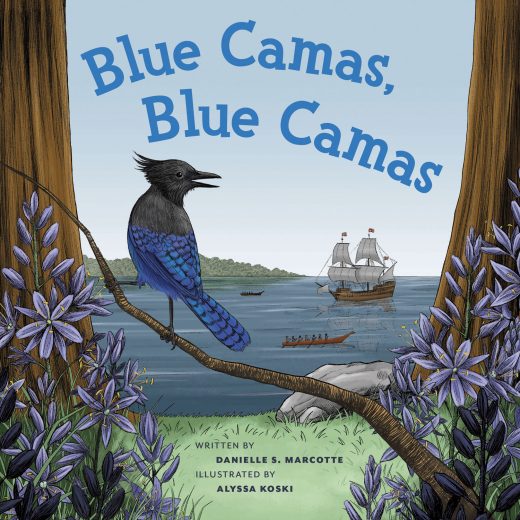 Blue Camas, Blue Camas
Blue Camas, Blue Camas
Text by Danielle S. Marcotte
Illustrations by Alyssa Koski
48 pp. Heritage House
Blue Camas, Blue Camas opens with the song sparrow rejoicing spring and the “blooming blue waves” of Kwetlal, or blue camas, that have been tended to and harvested by west coast First Nations for millennia. Enchantingly, birds continue to be the primary narrators, with the song sparrow joined through the pages by an orange-crowned warbler, a crow, a Steller’s jay, a cedar waxwing, and a northern pygmy owl.
The avian narrators watch as the land before them changes with settlement and the arrival of a family from far away who see their new home as a “paradise” but also land to be changed. “This untilled land will make a splendid farm,” the father announces to his son from the deck of a ship approaching shore. “When I plow it, I’ll grow oats, carrots, wheat, parsnips, and potatoes.” Alyssa Koski highlights this disparity in her illustrations, using a vibrant color palette for the pre-colonial landscape with its bright meadows and rich biodiversity, and more muted tones for the settlers’ farms.
Writing a picture book about colonization and its effect on Indigenous peoples and the environment is a challenge few might want to take on, but author Danielle S. Marcotte approaches the subject with sensitivity and finesse. Through the perspective of two children, a First Nations girl and a settler boy, she touches on the heartache and confusion that arise when worldviews clash. “How is it that two groups of people could look at the same land but view it so differently?” Marcotte writes in her endnotes. Using birds as narrators helps, and it’s they who make heartbreaking observations—of a “great illness,” fences that divide the land and keep the girl’s family from their Kwetlal meadows, and “strange words” whose meanings they try to decipher.
Blue Camas, Blue Camas tackles a difficult subject but provides multiple opportunities to develop empathy and to understand that there is more than one way to view the world and interact with the land.
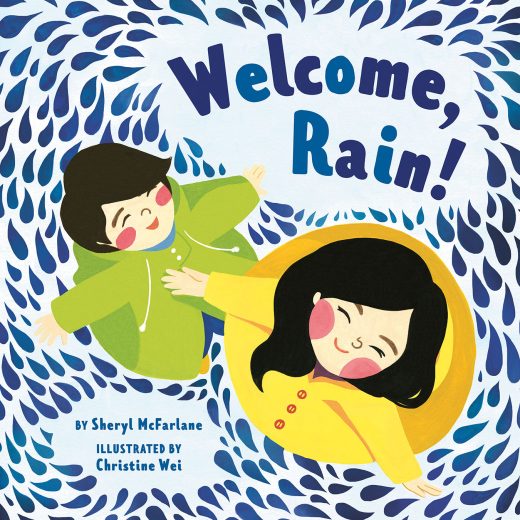 Welcome, Rain!
Welcome, Rain!
Text by Sheryl McFarlane
Illustrations by Christine Wei
40 pp. Greystone Kids
Children have a lot to teach us when it comes to observing the world. This comes through joyously in Welcome, Rain! when the book’s young protagonists talk directly to Rain: wishing it good morning, inviting it to play, and thanking it for all it does, including helping gardens grow and keeping forests green.
At first, the children splash in mud puddles, watch robins pull worms from the damp soil, and appreciate that rain brings them water for hot baths and their mother’s tea. Even they eventually have their fill though, and gently suggest that Rain might want to take a little break. “But maybe that’s enough now, Rain”—the creeks are full, and thunder scares the dog. By summer, the kids are scooting along the sidewalk sans rubber boots and raincoats until, well, it’s too hot. Then, “We miss you, Rain.”
This charming book beautifully captures our relationship with rain—we need it, we don’t always love it, but we sure miss it when it’s been gone too long. Author Sheryl McFarlane imbues her text with sensory details: rain has a “fresh happy smell,” dried grass is itchy, raindrops are savored on the tongue and sparkle in spider webs, and rain on the roof is a “bedtime pitter-patter lullaby.” Christine Wei employs vibrant colors and varied perspectives—from images where children are in scale with their environment to those in which they shrink to the size of strawberries and use flowers for rainhats.
Library shelves are filled with books on the water cycle, but in Welcome, Rain! we’re living our relationship with water through the eyes of children, remembering the fun of mud puddles and smelling the scent of fresh rain on hot pavement right along with them.
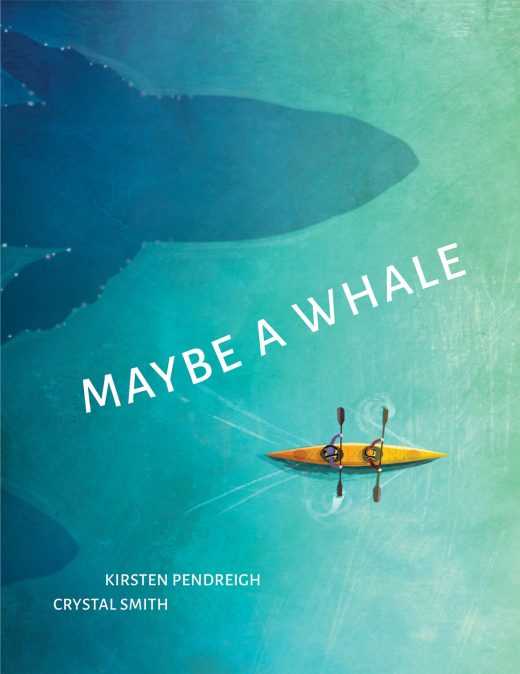 Maybe a Whale
Maybe a Whale
Text by Kirsten Pendreigh
Illustrations by Crystal Smith
36 pp. Groundwood Books
After her beloved grandfather dies, a girl takes a kayak trip with her mother. “Mom says the trip will do us good,” says the girl. “I don’t think she’s right. Grandpa won’t be there.” But, it’s a trip he had planned for them, and there is the allure of seeing whales, so they set off—“I squeeze on scratchy water shoes, heavy rubber pants, and a lifejacket that hugs me tight. Like Grandpa did.”
The young girl is skeptical they’ll see whales—“How could you find a whale in all that water?”—but as they paddle, they see many other things: seals whose dark eyes meet theirs, swarms of moon jellies, and bioluminescence that lights up the sea. As the days pass, their smiles start to return. Eventually, they hear a pushhhh! coming from the ocean.
Maybe a Whale is a story about grief and finding connection with those who are with us and those who are not, set against the backdrop of reflective time in nature. The text is spare yet lyrical and alternates between narration and the girl’s inner thoughts; we’re right along with her as she explores the coast, remembers her grandfather, and searches for whales. The layered and luminous illustrations portray the coast from many vantage points and echo the outer and inner journeys of mother and daughter. Maybe a Whale reminds us that memories can keep loved ones close, even when they’re gone.
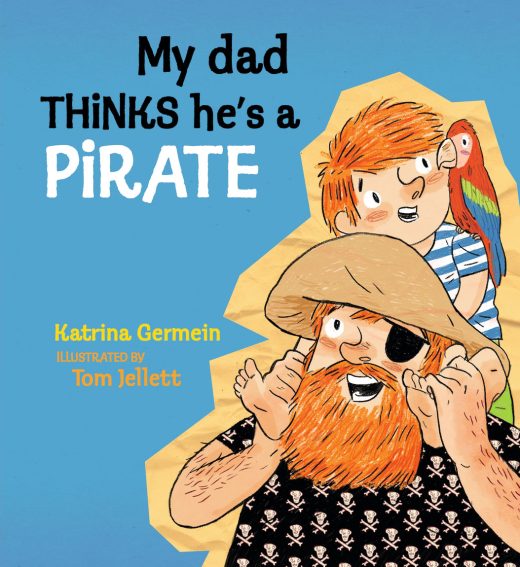 My Dad Thinks He’s a Pirate
My Dad Thinks He’s a Pirate
Text by Katrina Germein
Illustrations by Tom Jellett
32 pp. Candlewick Press
“My dad thinks he’s funny,” the narrator of My Dad Thinks He’s a Pirate begins. It’s hard to tell whether the boy is amused or exasperated by his father—perhaps he’s just humoring him—but anyone who loves a good pun will enjoy this visit to the beach with its seaside-themed jokes.
As the father-son duo swims, fishes, and explores the seaside, Dad always has a joke or three, and each spread ends with the refrain, “My dad thinks he’s a pirate,” which invites children to chime in. For the most part, the jokes are of the roll-your-eyes-and-groan sort—“Watch out for shellfish. They make me crabby.”—but others require a sophistication with wordplay that may be beyond the language abilities of some young readers. For example, “We need some music, something catchy. How about opera? I love the high Cs.”
Will every child get every pun? Probably not. But they can enjoy the illustrations and the obvious fun the two are having and will no doubt laugh uproariously at the token fart joke.
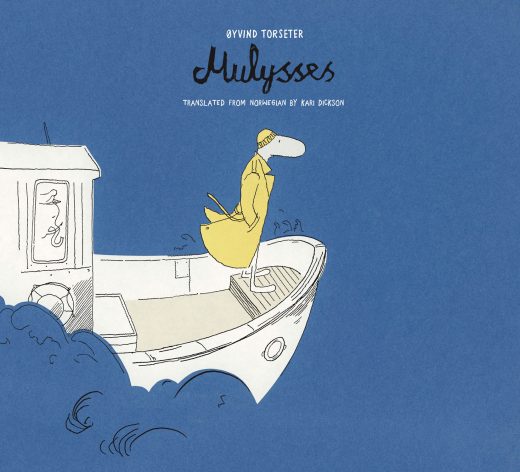 Mulysses
Mulysses
Text and illustrations by Øyvind Torseter
Translation by Kari Dickson
156 pp. Enchanted Lion Books
Poor Mulysses. His apartment is slated for demolition, his possessions have been seized, and he’s botched several haircuts, so he’s lost his job as a stylist. So begins his quirky tale brought to the page as a graphic novel, Mulysses, by Norwegian author-illustrator Øyvind Torseter. A note from his landlord nailed to Mulysses’s apartment door lets him know he needs a quick $5,000 to get his possessions out of storage. Despondent, Mulysses heads for the tavern in search of “something strong.” (This detail alone makes it clear we have a European book on our hands.) His vice is chili nuts; his drink is coffee. Sitting at the bar, he overhears someone bemoan that “no one is adventurous anymore.” This character—part man, part elephant, for reasons unclear—is a millionaire explorer and collector who, as it turns out, is serendipitously looking for someone to join him at sea. His goal? To find the world’s biggest eye, for which he’ll pay—surprise, surprise—$5,000.
Of course, Mulysses signs up, and, after stocking up for the expedition, the pair is off on a seafaring romp that remixes bits from The Odyssey (sirens, harps, and a cyclops) and Moby-Dick (a whale, this one missing an eye) in a mash-up that I can pretty much guarantee is unlike most books young readers usually find on the shelves.
The story’s eclectic and unusual narrative will be confusing to some, and many of the jokes will be lost—such as the response by Mulysses when the captain asks him if he has any previous experience as an explorer: “I’ve been to Sweden.” But there is much to pore over in these pages, and keen readers, perhaps with the assistance of a helpful adult, will enjoy the hero narrative.
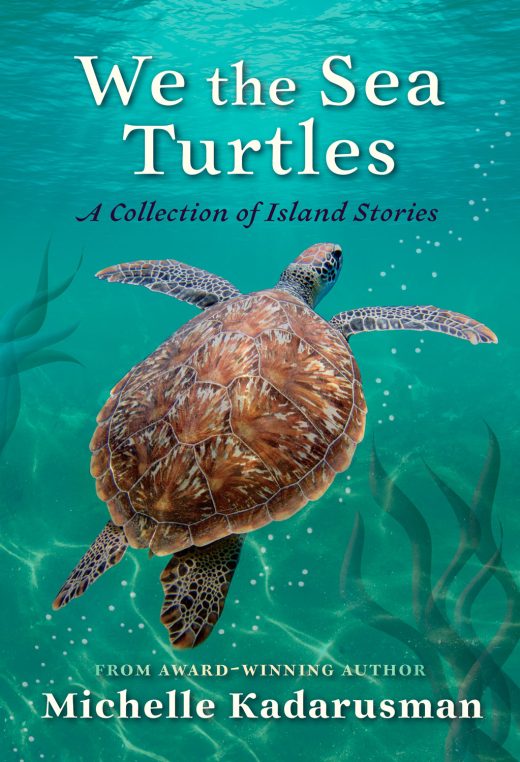 We the Sea Turtles: A Collection of Island Stories
We the Sea Turtles: A Collection of Island Stories
Text by Michelle Kadarusman
208 pp. Pajama Press
Turtles link this collection of nine short stories for children ages nine to 14. Based in various locations, from Canada to Malaysia to Denmark, the tales in We the Sea Turtles all touch on life-changing moments in children’s lives. In a story based in Indonesia, for instance, a young girl who’s lost her father in a tsunami imagines him reincarnated as a kura kura (sea turtle); and in Florida, a young eco-warrior, who can’t seem to get his family to care about the world as much as he does, channels his frustration by volunteering to help protect beaches where sea turtles nest.
The stories all have strong environmental themes, particularly of pollution, habitat disturbance, and climate change. The characters and settings are diverse, giving readers opportunities to sympathize with young people who have eco-anxiety or who are experiencing the impacts of climate change firsthand. Readers will also be inspired by the myriad ways the young characters choose to make a difference.
The collection ends with a narrative written from a sea turtle’s perspective. “After a lifetime of adventure, I turn toward home,” the sea turtle begins, and it’s from this section the book gets its title: “We the sea turtles are ancient stewards of our planet.” A resource guide for educators offers excellent ideas for discussion and action.

